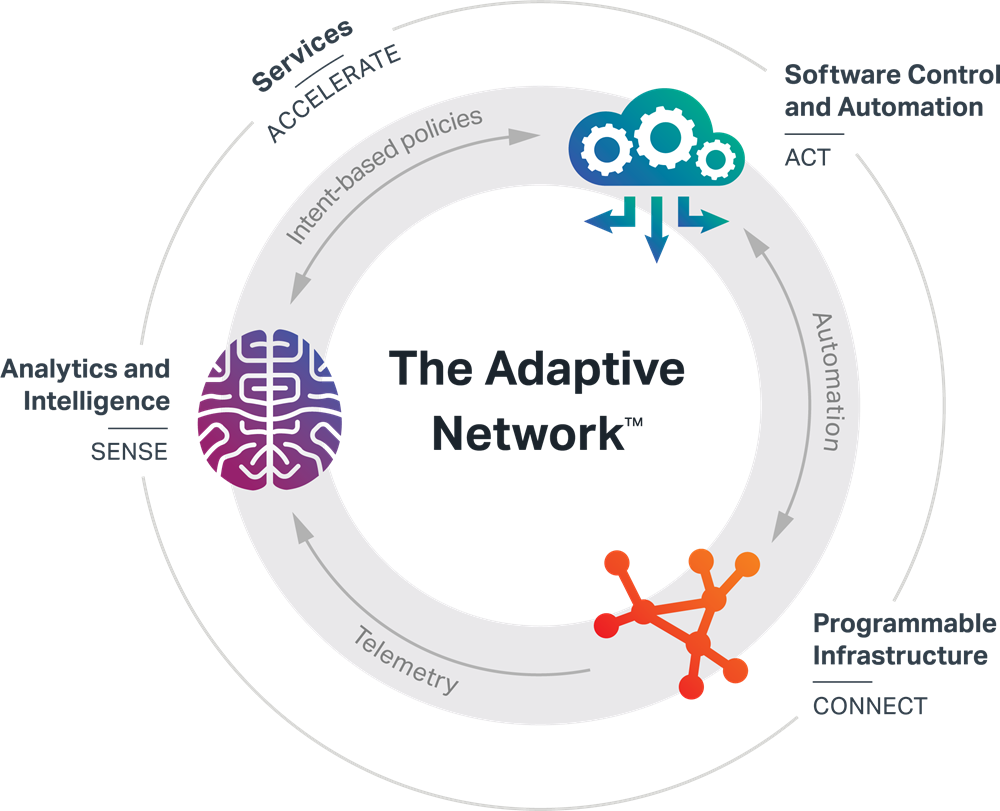Enterprise trends: Cloud, digital transformation, and the move to the Adaptive Network
Before the world went digital, bringing new customers to an enterprise’s marketplace was a pretty straightforward process. Buyers had access to only limited sources of information, allowing the sellers to control the entire journey from discovery to sale to partnership.
Global digitization has changed this dramatically. Buyers have access to almost unlimited information and are entering the sales process well aware of the pluses and minuses of every sales equation, and are very quick to change relationships for a better deal. They are demanding the same type of predictive, personalized, and custom experience they receive from digital innovators like Amazon, Google, and other leaders. And, to add to all this, buyers are asking for service and applications access 24 x 7 from multiple types of devices –including mobile devices.
This means that enterprises in every industry vertical must now be hyper-focused on providing a higher quality customer experience, actively partnering with customers who are willing to advocate in terms of this better experience. It also means that the network that underpins this relationship has to change and adapt.
What trends are we seeing?
Enterprises have wholeheartedly embraced the move to cloud architectures and are now actually taking better advantage of the cloud’s abilities. Many enterprises have begun transforming themselves to a more “platform-ized” model by using Application Programming Interfaces (APIs) to bundle applications and services from multiple and sometimes competing vendors and then deliver these bundles through a single platform/portal to the end customer.
Banks are partnering with FinTech and digital financial services companies to bundle their respective services into a user portal that delivers multiple services to their customers. Smart cities are bundling capabilities and applications from different agencies, jurisdictions, academia and private industry and delivering them to citizens and businesses through one portal that requires a single sign-on versus requiring a separate sign-on for each separate agency.
Enterprises are also transforming and modernizing their branch structure to get closer and stickier to their customers, all while seeking to reduce the high costs of maintaining multiple brick and mortar branches. They are even experimenting with size and locations of these branches while prioritizing the digital and virtual capabilities of each branch, regardless of the local population served by a particular branch.
Bank and retail branches can range from tiny kiosks to very large “community centers” that combine the core bank/retail services with conference rooms, free Wi-Fi, coffee shops, and community events. Diverse service types are delivered via interactive digital wall screens, virtual and augmented reality, and video-consultations with remote experts.
Healthcare companies are partnering with retail pharmacies and insurance companies to provide video-based telehealth services and primary care diagnosis within the retail pharmacies, pushing their abilities ever closer to the end user.
What does this mean to the network?
To achieve all these objectives, enterprises are deploying technology innovations including artificial intelligence (AI), machine learning (ML), robotic process automation, IoT, analytics, edge computing, Blockchain and others. Many of these are cloud-based applications, so branch and kiosk connectivity to cloud apps must happen in real-time, with low-latency, scalable bandwidth, and resilient connections. Any network outages, congestion, or jitter can impact the enterprise’ ability to support their customers.
Security and privacy of data is also critical. As enterprises deploy more sensors, devices, and AI/ML-based applications, they must balance the need to share data across a wider ecosystem, with the need to ensure data security and privacy - or risk losing customers due to breaches in addition to fines from regulatory authorities.
Yesterday’s static and aging network infrastructures are not well suited for this new environment. In order to deal with all these new complexities, enterprises now require network infrastructures that are more adaptive, more dynamic, and more responsive. And we are seeing this – every day. More and more providers are offering flexible virtualization services, customer portals, and scalable bandwidth – all based on the Adaptive Network from Ciena.
The Adaptive Network
At Ciena, our vision for a network infrastructure capable of dealing with the new trends and responses can be boiled down into three simple words – Connect, Sense and Act. These three words are the basic tenets of the Adaptive Network.
Connect – or the Programmable Infrastructure: A programmable packet and optical infrastructure is one that can be accessed and configured via common open interfaces, is highly instrumented, with the ability to export real-time network performance data, and can adjust its resources as needed to meet the demands of the applications running on top of it.
Sense – or Analytics and Intelligence: Collecting network performance data, and analyzing this data using machine learning and artificial intelligence (AI), provides the ability to more accurately predict potential network problems and anticipate trends by turning mountains of data into actionable insights. Leveraging these insights can help develop smarter, data-driven business policies that adapt to customer needs securely, and in real time.
Act - or Software Control and Automation: Multi-Domain Service Orchestration (MDSO), federated inventory, and centralized, software-defined control of individual domains form the basis of adaptive networking. Through the implementation of SDN, NFV, and open APIs, the end-to-end management and automation of network services across multi-vendor, hybrid networks can be simplified.

By building a framework around these three concepts, an enterprise can turn their infrastructure into a self-optimizing, self-managing and self-configuring network – one controlled by intent-based policies and open to multi-vendor hardware and software; one that is truly dynamic and responsive, and one that can pass these capabilities on to its customers.
The true leaders in today’s crowded marketplace are those who harness the power of their network not just to support their businesses, but to actually fuel their businesses.





